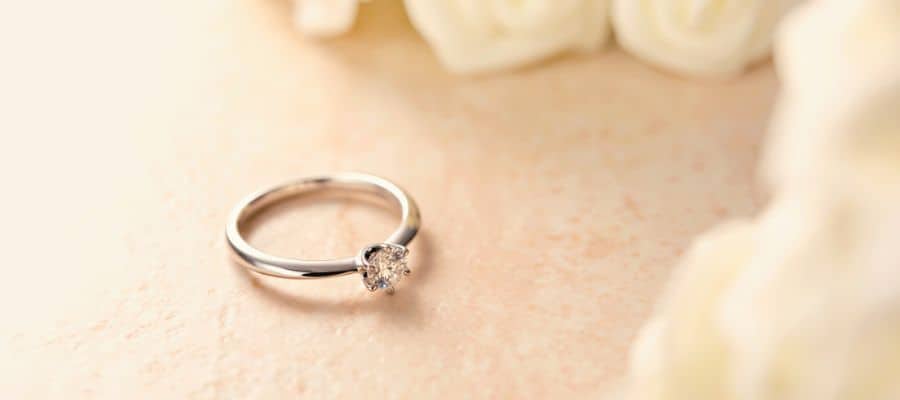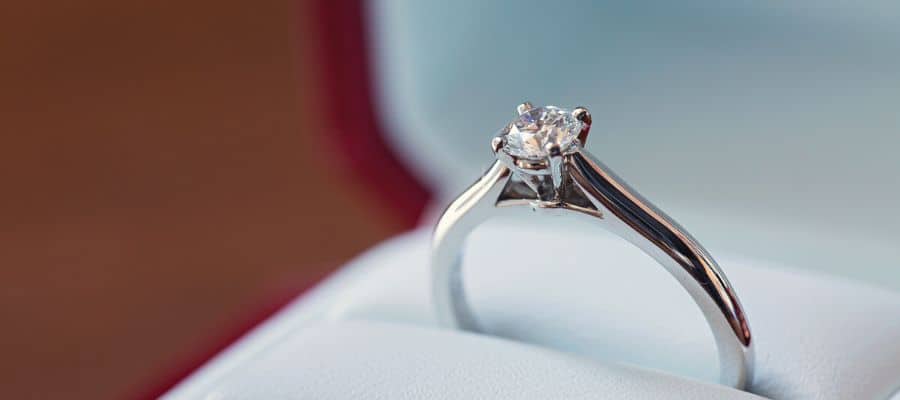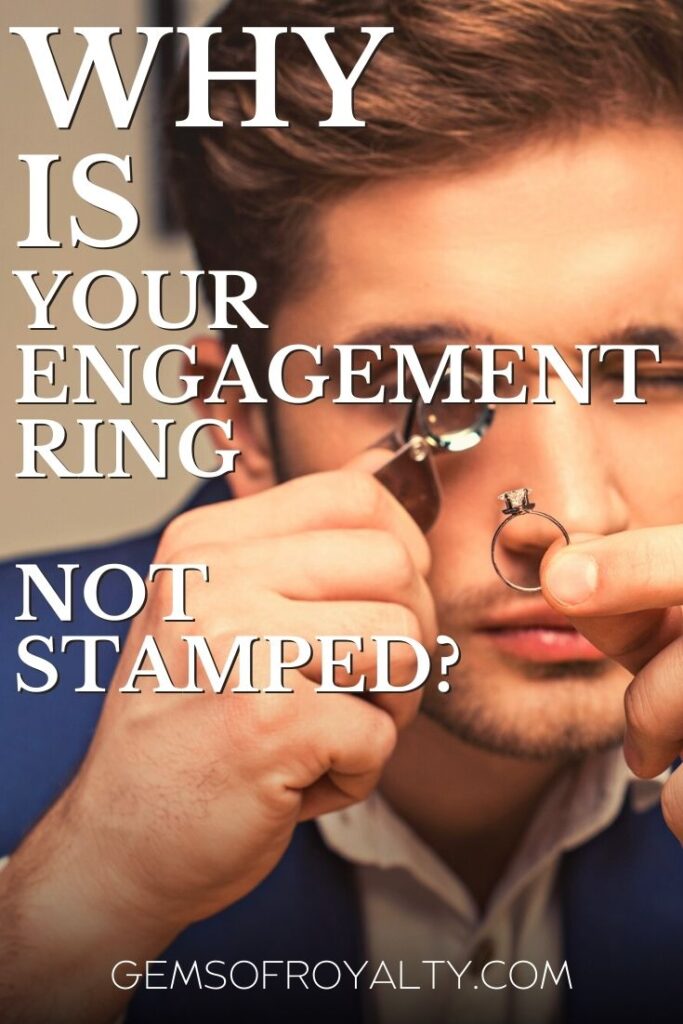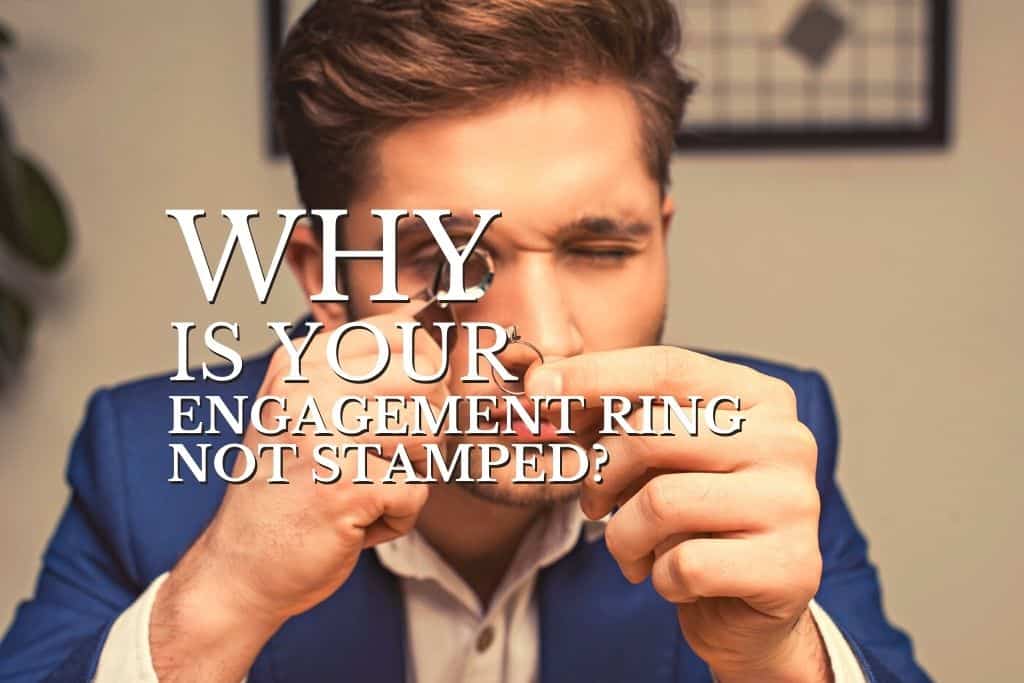Engagement rings symbolize a promise of marriage and a lifetime of commitment within a relationship. When made with real precious metals, these rings often include a mark on the inner band to indicate the fineness of the gold, silver, or other material. However, not all engagement rings have a hallmark—so what does it mean if an engagement ring isn’t stamped?
An engagement ring may not be stamped if it’s not manufactured or sold within the U.S. or U.K. Some antiques have stamps that have worn off over time. Custom-made rings that were never sold by vendors don’t require stamps. An unstamped ring may also mean the ring isn’t made with precious metals.
This article discusses whether an engagement ring can still be made of precious metals if it lacks a hallmark, as well as several reasons why an engagement ring may lack a quality stamp. It also briefly discusses counterfeit hallmarks on jewelry. Read on to learn more.
Can an Engagement Ring Still Be Real if It’s Not Stamped?

An engagement ring can still be real if it’s not stamped. It may have been manufactured prior to 1906 or custom-made by a consumer and never sold by a jeweler. It’s also possible the stamp has worn off with time, especially if the ring is older than a decade and made with a soft metal, like gold.
In the United States, all engagement rings and other jewelry made with precious metals after 1906 should be stamped with a quality mark prior to sale by a jeweler. The hallmark on engagement rings indicates the fineness of the metals used in the jewelry’s construction, and the trademarks place responsibility on the manufacturer in case of inaccurate quality stamps.
These legal requirements are in place thanks to the National Gold and Silver Stamping Act of 1906 (or Jeweler’s Liability Act). It’s important to note that the act was never about indicating jewelry quality, and there is no current law requiring anyone to mark gold or silver jewelry when sold or exchanged among consumers.
In other words, if a person (not a business or jeweler) melts gold or silver and creates their own custom engagement ring, then sells it to a friend or family member, they aren’t legally required to stamp it. On the other hand, if a jeweler melts precious metals and designs their own ring to sell, it must be marked with a trademark and stamped to indicate fineness.
Reasons an Engagement Ring Doesn’t Have a Hallmark

If your engagement ring doesn’t have a stamp on the inner band, don’t automatically assume the ring is a fake. There are several reasons why an engagement ring may not have a hallmark, as discussed below.
The Ring Wasn’t Manufactured or Sold in the United States
In the United States, there are strict rules and regulations regarding the stamping of jewelry to indicate fineness. Most European countries also have stringent requirements regarding hallmarking jewelry made with precious metals. Laws differ in some areas, however.
For example, in Italy, fineness marks on jewelry aren’t required, but jewelers must include the maker’s mark. These stamps do not indicate the exact fineness of the piece, but it does serve as a sign of the jewelry’s quality and ensures the engagement ring was sent to a third-party jeweler or laboratory for purity testing to guarantee authenticity.
Rules and regulations concerning jewelry purity outside the United States and the United Kingdom may be less stringent or even non-existent. Purchasing engagement rings from countries without strictly enforced jewelry hallmark requirements could cause you to end up with a counterfeit engagement ring.
In addition, street vendors in countries across the globe often sell gorgeous rings in street markets or tourist attractions. While the jewelry may be stunning, there’s no telling whether it’s real without testing it for purity. In most cases, these sellers aren’t using authentic gold or silver, regardless of what they say or what the price reflects.
The Stamp Wore Off Over Time
Family heirlooms and antiques passed down for generations may have stamps that have worn off or rubbed out over time due to excessive wear. Gold jewelry, in particular, is susceptible to thinning over time, as the metal is particularly soft. This typically takes anywhere from a decade or more to happen.
When rings are passed down, the new wearer often has the ring resized or polished to fit or restore its luster. These treatments can also remove the original stamp. However, most jewelers restamp the jewelry after resizing or polishing the ring since it’s a relatively simple process.
The Engagement Ring Was Never Stamped
As mentioned previously, the Jeweler’s Liability Act wasn’t implemented until the first decade of the twentieth century. Engagement rings manufactured prior to 1906 or custom-made rings never sold by a jeweler may have never had a fineness stamp.
Not only that, but the act was put into effect to hold jewelers accountable for selling counterfeit jewelry or false advertising. This is precisely why the law also requires a trademark in addition to the fineness stamp. The law doesn’t include consumers, who can legally sell handmade or custom-made jewelry, including engagement rings, without a hallmarking requirement.
Engagement Rings and Counterfeit Hallmarks

A stamp doesn’t guarantee authenticity, just like an unstamped ring doesn’t mean the ring’s a fake. There are counterfeit engagement rings on the market, despite the laws in place to prevent misleading advertisements or inaccurate stamping. For example, the karat stamped on the ring may be inaccurate or designed to mislead consumers into thinking the item is solid gold when it’s actually plated.
That said, if the ring is brand new and sold by a jeweler in the United States and still doesn’t have a quality stamp, you can almost guarantee it’s not real. This is because all rings sold by jewelers in the United States must have a hallmark indicating fineness and a trademark. Without it, they are technically in violation of the National Gold and Silver Stamping Act of 1906.
Conclusion
When purchasing an engagement ring or attempting to determine if your engagement ring is made with authentic precious metals, don’t rely on a stamp to indicate fineness. The only way to determine if your jewelry is real is to have it tested using guaranteed methods at a local trusted jeweler.
For future reference, it’s best to avoid purchasing unmarked jewelry unless you can have it tested for authenticity before committing to purchasing.
If you found this article useful, make sure you save this pin below to your Jewelry board.


